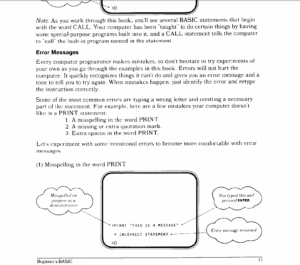Technology’s been a pretty big part of my life for as long as I can remember. My mother was a speed typist and worked in data entry, and I loved to imitate her typing when she sometimes had to take me to work with her. (I wound up “inheriting” her typing skills with well over 100 wpm and 99% accuracy average. You’d be surprised how advantageous my typing skills turned out to be – being an excellent typist led me down the path to web development and into a career that rescued me from a place where I would have wilted on the vine and given up.)
 When I was young, around 9 or so, my parents got a Texas Instruments computer that I immediately laid claim to. I started out by playing Pac Man and a car racing game called A-Maze-ing. Back then, games came on clunky cartridges that were a little bigger than cassette tapes. (“Cassette tape? What’s that?”) I loved playing those games, but I loved typing even more. I then got a subscription to a kids’ computer magazine that featured a different programming concept each month, so I began learning to program using BASIC. I would diligently type out lines and lines of code that took me about 45 minutes to create “Mr. Bojangles.” Mr. Bojangles was a block-figure that changed color and would “dance.” I quickly learned how to manipulate and change the colors and movements, eventually moving on to other concepts. (I did a quick search online and turned up this and this. If it looks familiar to you, or you understand everything I’m talking about… congratulations! You’re an old Gen-Xer like me.)
When I was young, around 9 or so, my parents got a Texas Instruments computer that I immediately laid claim to. I started out by playing Pac Man and a car racing game called A-Maze-ing. Back then, games came on clunky cartridges that were a little bigger than cassette tapes. (“Cassette tape? What’s that?”) I loved playing those games, but I loved typing even more. I then got a subscription to a kids’ computer magazine that featured a different programming concept each month, so I began learning to program using BASIC. I would diligently type out lines and lines of code that took me about 45 minutes to create “Mr. Bojangles.” Mr. Bojangles was a block-figure that changed color and would “dance.” I quickly learned how to manipulate and change the colors and movements, eventually moving on to other concepts. (I did a quick search online and turned up this and this. If it looks familiar to you, or you understand everything I’m talking about… congratulations! You’re an old Gen-Xer like me.)
Do you remember the first days of the internet and email? I do. My first email was through Juno, and I can tell you the very first time I encountered “the internet.” It’s an amusing story. I used to hang out with a bunch of guys who were a few years older than me, when I was around eighteen. They were my introduction to the X-Files (we used to gather to watch it every Friday), to the board game Axis and Allies, and Call of Cthulhu. If you don’t know what CoC is, think Dungeons and Dragons, but nerdier. *smile* I’ll bet you’d have never guessed that I used to spend weekends playing dorky games and geeking out to X-Files with a bunch of guys. I did. I did, indeed. And I loved it. (We also used to drink and party a lot in between, so there’s that.) Anyway. My introduction to the internet was when one of the guys got internet (dial up!) and AOL. The very first time I got online was to play Call of Cthulhu in a gaming chatroom on AOL.
Yup. Let that sink in for a moment.
Moving on.
I honed my typing skills, thanks to having a computer at home and middle school typing classes. We had computer classes in high school, where I learned to use word processing software, and though that particular teacher was known for his creepy behavior, it was my favorite class because I loved typing and using the computer. (When playing Call of Cthulhu online, the guys would always have me do the typing because I was so damn fast.) I eventually began temping through Kelly Temps and Manpower, where my typing skills got me free classes, and I never met a computer concept or program that I couldn’t conquer. I eventually got a job as a “web technologies instructor” without knowing much about the software or technology I was supposed to teach, but I learned it all within a week. I taught myself how to install Movable Type (back in the early blog days, long before “one-click installs”), taught myself CSS, refined my HTML skills, learned JavaScript and PHP through blogging… then eventually moved on to JOOMLA, Drupal, and transitioned to WordPress. If you present me with something new to do outside the computer world, I might get flustered and anxious about figuring it out. If you ask me to do something on a computer or a website, I’ll dive right in and master it.
I often look back at those times and wonder where I’d be had I taken proper programming classes. I imagine I’d be a highly paid programmer… but I’m totally fine with the fact that I’m not. I mean, I did pretty well for myself as a web developer, but I had chronic back pain, pinched ulnar nerves that caused numbness traveling up the side of my pinky to my elbow, and my eyes were perpetually dry. This was before I started doing yoga, which helped A LOT. But if you know anything about ADHD, you’ll know there’s this thing called “hyperfocus” and that’s what computers do to me. I used to be the girl in the corner of the office with the lights out, headphones on, face illuminated by the glow of a screen covered in code. Coding, writing/blogging, editing photos, writing tech manuals, developing websites – it puts me in that “flow state.”
But so does writing. And learning foreign languages.
So, when my son was born, I declared NO SCREENS. He didn’t watch TV, didn’t touch my phone, didn’t have an iPad… He didn’t see his first movie, at home or in theaters, until he was six or seven years old. Around that same time, I started allowing him to watch movies or cartoons on the weekend—the amount of time equal to one movie on Saturday and on Sunday. And I have to tell you – given how isolated he was from pop culture and TV shows, it is astounding how much he knew about pop culture and TV shows. The power of your peers, man.
Over a couple of years, a little more screen time crept in. We eventually got an iPad for him to watch movies on the long flight to Grandmom’s and gave him limited time to play video games. (We have every console known to man thanks to my husband’s work history in video games.) Then he became obsessed with Minecraft…
Flash forward to now.
With what little screen time he’d been given in the those earlier years, I saw the same aptitude and affinity for computers that I had. We’d tried sending him to various “camps” over the years, and he always hated them. Then we sent him to a Minecraft Modding camp a couple Summers ago, and I have never seen a kid as excited as he was about this class. He loves to play, but he loves building his own worlds and creating even more. We continued to sending him to weekly coding classes, where I was told his progress was far above average. His favorite thing to do, after reading, is get online and code. Last year, he was working on a “movie” (an animation in Scratch) and spent a lot of time creating worlds in Minecraft. He’d decided he wanted to make his own server, so he began creating a server manual. (Through writing this manual, which he’d chosen to do voluntarily, he was practicing writing skills, problem solving, planning, showed an understanding of formal versus informal language, organization in writing, tech lingo, spelling, etc.) This year, he’s moved beyond Minecraft into Roblox (using Lua)… and he’s also been learning Python and Unreal! He’d begun to get impatient in the coding classes because he quickly grasped the concepts they were teaching and wanted to do more, more, more. He kept coming up with big ideas that the teachers didn’t want to answer because they were far beyond what was being taught at the moment. (And I understood this—the teachers had to follow a set curriculum and manage several other kids in the class.) I got him a subscription to CodaKid where he can go through modules at his own pace, skip ahead and make up his own stuff. I, of course, have been teaching him how to make websites and work with WordPress. When he’s a little older, we’re going to sign him up for more advanced coding classes through programs at local colleges.
Then there’s still the fact that we homeschool—he takes several online classes through different schools, and he loves them. He does science classes, Spanish, critical reading classes, etc. We have a subscription to Curiosity Stream an app/channel (iPhone, FireTV) that curates documentaries on every topic under the sun. He often chooses shows on outer space and weather, but has occasionally chosen series on historical topics and geography. Additionally, he’s a writer, like me! When he announced that he wanted to start working on a book, with chapters and all, I immediately showed him how to use Google Docs. Here’s the thing about people whose brains are on fire and whose ideas come at the speed of light: Pens and pencils can’t keep up. When I was his age, I was constantly writing in journals and notebooks. My hands were always cramped, and my writing got messier and messier because I physically could not keep up with the words I wanted to write. Learning to type was a godsend. I love hoarding colorful notebooks (Leuchtturm’s are my jam!) and writing supplies. I love it so much that I have a German, metallic pencil sharpener on my key chain that I use often. My notebooks are full of scribbled sentences and ideas, but when it comes to turning those ideas into something, I have to type. When I write by hand, I get frustrated and lose steam. Typing lets me brain-dump at the speed of thought. (He’s also learning to type properly, but in the meantime, his “hunt and peck” typing is astoundingly fast.)
Some days I cringe, when I realize how much time he spends staring at screens, but overall… f*ck it. I had to let go. Computers work for him. He’s gifted, he learns differently, and these are serious, real-world skills that he’s learning.
 My son also has ADHD, but it’s not something that we’ve really needed to manage much. Being homeschoolers, it actually kind of works – he’ll sit and code or read or do science experiments for HOURS without looking up. He needs time to be in that flow state, which there is absolutely no opportunity to get into in a brick and mortar school. At home, he can immerse and learn to his heart’s content. At home, we’ve found a way to both give him time to immerse and taught him about the importance of managing time and creating structure. I’ve been truly impressed with the self-discipline he’s cultivated, all on his own, in order to get things done that need to be done in order to spend time immersed in his projects.
My son also has ADHD, but it’s not something that we’ve really needed to manage much. Being homeschoolers, it actually kind of works – he’ll sit and code or read or do science experiments for HOURS without looking up. He needs time to be in that flow state, which there is absolutely no opportunity to get into in a brick and mortar school. At home, he can immerse and learn to his heart’s content. At home, we’ve found a way to both give him time to immerse and taught him about the importance of managing time and creating structure. I’ve been truly impressed with the self-discipline he’s cultivated, all on his own, in order to get things done that need to be done in order to spend time immersed in his projects.
These are all reasons I had to decide to be ok with the screens. Computers work for him. Computers and games helped him get over his extreme math anxiety. He used to struggle with basic math facts and still uses his fingers… but if I ask him how many robux (Roblox “game currency”) he can buy with his birthday money, he’ll do the math in his head and whip out the answer (which is in thousands) in less time than it takes to blink.
All of these computer-related activities bring in so many skills: problem solving, dealing with frustration, writing, planning, critical thinking, social skills, and yes… numbers. Never mind the fact that programming and coding are marketable skills. He’s got three “real life” best friends, but he also really loves interacting with other kids online in his game worlds. It turns out that this is a safe space to navigate social situations—he’s smoothly dealt with bullying, he stands up for other kids, he knows when to ask moderators to step in. I’ve watched this socially awkward kid, who would come home from brick and mortar school depressed and deflated, absolutely thrive and shine and be more “himself” than he’s ever been since moving to homeschool and allowing him to play games on online servers. We monitor it, of course, but I don’t feel a need to check in as often as I did when he started. We’ve had plenty of opportunity to talk about what’s appropriate and what isn’t, that you don’t share personal information online, that you come to us if you encounter someone that’s freaking you out, etc.
Besides, there’s still a balance. He rides his bike and his scooter, does archery lessons, is obsessed with his weekly Parkour class, does 4-5 mile walks with me in the woods several times a week… but being given the time to figure out who he is and just be himself at home, and online, has given him the confidence to go out and enjoy these activities with other kids, which he didn’t before. I really wish I’d had these options when I was his age. Then again, it’s so much worse these days (schools, bullying, other kids) than it was back in my day. I’m just glad these options are available now.


Pingback: Homeschool: the First Six Months – Dopamine for the Soul